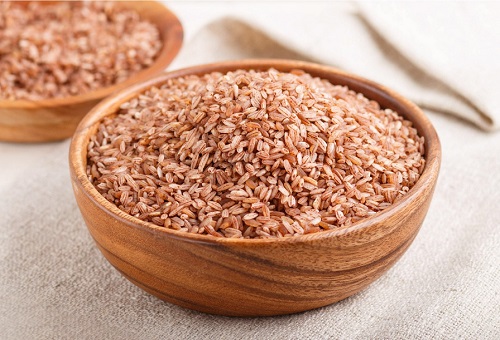Brown rice is an unrefined and unpolished whole grain that is formed by removing the surrounding hull of the rice kernel. Its grain retains its nutrient dense bran & germ layer. It is chewier as compared to white rice & has a nutty flavor.
Brown rice is whole-grain rice with the inedible external hull removed. Brown rice is food often related to healthy eating. Considered as a whole grain, brown rice is less processed than white rice, which has had its hull, bran & germ removed. Brown rice has the hull (a hard protective covering) removed, leaving the nutrient-packed bran & germ. Brown rice retains the nutrients that white rice lacks such as vitamins, minerals & antioxidants.
Brown rice is a seed inedible husk that has been removed (via milling). Brown rice normally has a distinctly nutty flavor and offers up grain with a good amount of “bite”, or chewiness. Dry brown rice will only last about six months at room temperature before the fatty bits in the bran and germ go rancid. Word has it that you can stave off the spoiling method for a good while by keeping your brown rice in the fridge or freezer.
Uses :-
Brown rice is richer in nutrients compared to white rice and provides numerous health benefits:
● Brown rice is a rich source of vitamins (folate and vitamin B2, B3, B5, and B6), fulfilling our body’s vitamin requirement to a great extent.
● This whole grain has a remarkable amount of manganese. Manganese is crucial for our body for many processes such as bone development, muscle contraction, functioning of the nervous system, and wound healing.
● Brown rice food has a lower glycemic index (GI), which helps in reducing blood sugar levels.
● Brown rice is an excellent source of antioxidants (flavonoids and phenol compounds) that prevent our body from various oxidative conditions.
● Compared to white rice, brown rice is a fiber-rich whole grain that helps in weight maintenance regimen.
● Brown rice is high in fibers, lignans, and magnesium minerals, which plays a critical role in keeping our heart healthy, thus reducing the risk of heart diseases.
● This whole grain is a gluten-free food product making it a food of choice for people intolerant or allergic to gluten-rich food.
● Brown rice also contains minerals such as iron, copper, zinc, phosphorus, and selenium that have countless health benefits.
Processing of Paddy for Brown Rice :-
In paddy processing, there are two main operations, viz. shelling or dehulling and milling or polishing. In case of parboiled rice, the paddy undergoes parboiling and drying before shelling and milling. The overall process and detailed step by step unit operations in paddy processing is given in flowchart and briefed below.
● Cleaning : Principle of cleaning paddy is based on different physical properties such as weight, size, density and properties of impurities, and paddy impurities lighter than paddy are removed by aspirators.
● Parboiling : Parboiling is a hydrothermal process that includes soaking, steeping and steaming, usually done to get parboiled white or brown rice. In soaking, the paddy is soaked either in normal or hot water for predefined duration. The soaking is the result of molecular absorption, capillary absorption and hydration. Then the soaked paddy is steamed/partially cooked in hot water or using wet steam. During steaming, the enzymes are inactivated; the endosperm becomes compact, translucent and pasty due to gelatinization; and crack in the caryopsis is also sealed.
● Drying : The parboiled paddy is required to be dried to moisture of 14–16% to obtain the desirable milling and storing properties. Traditionally, drying is carried out on open yards (sun drying), and the process usually goes up to 5 days depending upon the ambient condition. In modern rice mills, continuous drying systems using hot air are used to make the process short and hygienic.
● Dehusking : The process of removing the husk is referred as dehusking or dehulling or more commonly as shelling. Separation of hull or husk from the paddy grains is carried out mechanically. Many machines have been invented with different working principles in order to make the dehusking process more effective.
● Separation : The output material obtained from the dehusking machine would be the mixture of dehusked rice (brown rice), husks and unhusked paddy. This mixture is subjected to sieving-cum aspiration to separate the desirables from the undesirables.
● Milling or Polishing : Removal of bran layers is called milling or polishing. There are two types of polishers, viz. abrasive and friction polishers, which are commonly used at commercial level in rice milling.
● Grading : After polishing operations, the milled rice contains head rice (unbroken rice), and brokens of different sizes. Separation of brokens from head rice is done with stage sieving machines.
● Bagging and Storage : Predetermined quantities (by weight) of rice are packed using automatic weighers and baggers. Continuous and enclosed flow through conveyors and pipes ensures dust-free bagging and finished products.
Research work on Brown Rice :-
Phytochemical Profile of Brown Rice & Its Nutrigenomic Implications
Whole grain foods have been promoted to be included as one of the important components of a healthy diet because of the relationship between the regular consumption of whole-grain foods and reduced risk of chronic diseases. Rice is a staple food, which has been widely consumed for centuries by many Asian countries. Studies have suggested that brown rice is associated with a wide spectrum of nutrigenomic implications such as anti-diabetic, anti-cholesterol, cardioprotective and antioxidant. This is because of the presence of various phytochemicals that are mainly located in bran layers of brown rice.

